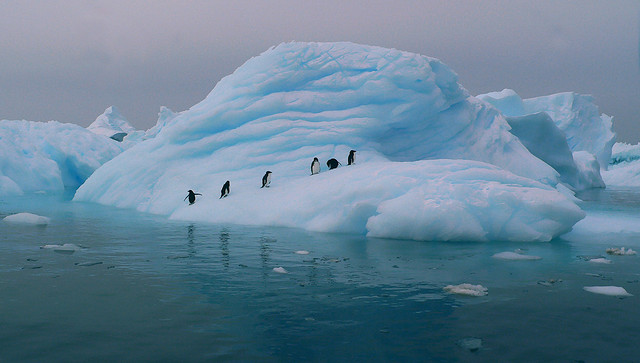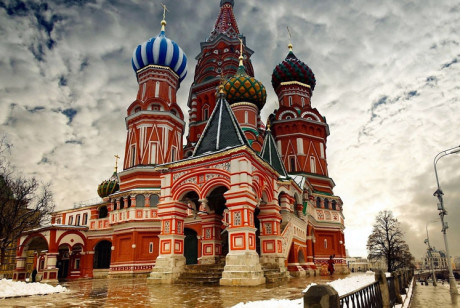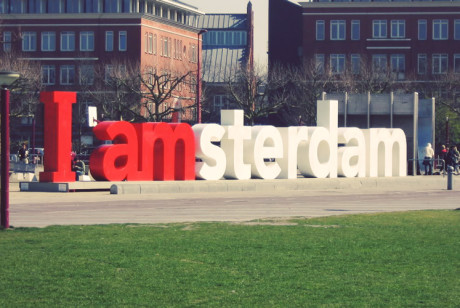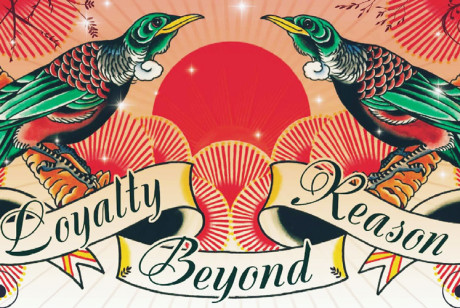Antarctica – Anything is Possible
Wednesday, 29 April 1998 - Christchurch, New Zealand

Presentation Summary
A Market Driven Perspective of Two Antarctic Futures. Antarctica, the most isolated and unspoilt place on earth, faces the prospect of a commercial future. This presentation to an audience of Antarctic opinion formers and policy makers presents a bold challenge to harness the considerable communication power of commerce to build Brand Antarctica in a way that fosters responsible attitudes among the world’s population.
Thank you for your invitation to speak here today about commercial opportunities and Antarctica. I’m honoured to be here, although I can’t say that Antarctica is something I’ve thought deeply about until recently.
Until I began thinking about this conference, about the closest Antarctica had ever come to my experience was the now-famous TV ad made by our Wellington office for Telecom New Zealand which featured penguins. Images of icebergs and penguins, when we were really thinking about toll calls.
My understanding of Antarctica is clearly incomplete, but I don’t think that I’m unusual in that. That issue, understanding, is the most critical of all the issues facing Antarctica today. Understanding, and fostering a better understanding is a large part what I want to talk about.
But first I want to establish a framework for my discussion. I would like you to consider what I say today against the backdrop of the Attention Economy. People today are time-poor, busy, stressed and there are increasing demands on their attention from almost everywhere. That makes attention the principle commodity of our time. It means that no matter what kind of business or organisation you are, your fundamental job these days is competing for attention.
Within this framework, I’d like to present you with two scenarios of the role commercialism will play in the future of Antarctica. Both of these hypotheses assume that large multi-national corporations will control the destiny of Antarctica in the future.This is the future of Kennichi Ohmae’s “Borderless World”. A world where the nation state has increasingly less influence on global affairs, and the most significant actors are large multinational, non-nationalistic companies. You can take issue with this idea in terms of the precise extent of influence companies will have versus countries, but the basic assumption, that companies will wield more and more influence is an undeniable trend.
Let me explain these two scenarios. One is a status quo story. It’s the bleak perspective of a commercial future for Antarctica. My second scenario is more optimistic. It takes inspiration from Saatchi & Saatchi’s own credo – Nothing is Impossible.The second Antarctic future has faith in the drive and vision of people involved in Antarctic science around the world. It presents a commercially driven Antarctic future in which Anything is Possible.
Now I’ll outline my first Antarctic future scenario. This is the business as usual story. This is what will happen if you in the Antarctic community do not make radical changes to the ways you have thought and acted up until now. Let me begin this view of the future where I started, at my desk at Saatchi & Saatchi thinking for the first time about the commercial value of Antarctica.
Saatchi & Saatchi Worldwide processes over $7 billion worth of advertising every year, and we have won numerous awards for the creative and innovative advertising approaches we employ for our clients.
We have never recommended to a client that they consider association with the idea of Antarctica in an advertising campaign. The reason is that the vast majority of people in the world don’t care about Antarctica. In fact, they don’t know about it. They don’t know about the science or the beauty, or the vital role Antarctica plays in the world’s ecological system. To most people Antarctica is a cold, distant, bleak place with penguins.The glaring fact is that there is little or nothing to encourage a company to utilise Antarctica in its advertising.
If you were to construct a set of brand values for the Antarctic from the popular perception of Antarctica now, you’d come up with something like this:
- Cold
- Lonely
- Empty
- Bleak
- Lifeless
- Isolated
- Impenetrable
- Distant
- Bad news
- Inevitable environmental degradation
- Penguins
You don’t have to be a marketing guru to realise that’s not an attractive selling proposition. Antarctica will continue to fall off the radar of popular perception. The great attention grabbing heroics of Amundsen, Scott and Hillary have been done. What remains is dry science and bleak possibilities – global warming and the degradation of the last unsullied place on earth. In a cynical world, the inevitability of environmental destruction is easy for the vast majority of people to swallow.
In my office when I first considered these Antarctic scenarios, I couldn’t see any potential for using Antarctica in my business. The only apparent immediate commercial value I could see came from Antarctic fisheries, tourism and the exploitation of minerals. Without Cold War geostrategic considerations, the strategic value of Antarctica to any country is based purely on its potential economic value. The greatest opportunities are undoubtedly connected to the continent’s vast untapped mineral wealth.
Given the inevitable decline of nation states and rise of corporations, the most influential Antarctica lobby will soon be oil and mining companies. Many companies, especially companies that focus on resource extraction, have no ethic higher than the profit motive. Of course individual shareholders, individual executives and customers are capable of higher motives and they can influence a company to be altruistic. But in the end, if there’s a buck in it, there will always be some company which does whatever is necessary to make a profit.
There’s nothing new in this view, you know the story: As technology makes it possible to exploit Antarctica’s considerable mineral resources, anti-exploitation sentiment among Antarctic Treaty nations will erode as a result of pressure from mining and oil companies. As soon as a company is satisfied that Antarctica contains commercially exploitable resources, and can see the benefits of extracting them, it will be easy to convince their home Governments that they should support altering the treaty to allow controlled exploitation.
This first Antarctic future sees an apathetic and ill informed global population passively watching as fisheries are exploited beyond sustainable levels, as tourists trample fragile eco-systems and as the environmental disaster of large scale mining is played out. This is a future of the Antarctic Ocean Desert, the Great Ross Sea Oil Spill, and Club Med South Sewerage Spread. The terrible prospect of this first scenario sounds like a story we’ve seen played out in almost every wilderness area which has been developed around the world.
It also sounds alarmingly like the world of Kim Stanley Robinson’s gripping new Sci Fi thriller, Antarctica. The plausibility of the disastrous scenario Kim unfolds in Antarctica is frightening. But I firmly believe that it doesn’t have to be like that.
I’m certain that the future will see increased commercial activity in the Antarctic, and that could well mean the exploitation of mineral resources. But I don’t subscribe to theories which say any economic development is bad. I believe in ideas like progress, and in the power of economic development to make the world a better place.
Companies will come to Antarctica for profit, and there are companies with no morality other than profit. But I believe in the power of the stakeholders – the shareholders, executives and customers – to influence the ways companies seek their profits. I believe people can guide companies to act in ways which are not the obvious and environmentally damaging shortcut to profit. This belief underpins my second vision of Antarctica’s future.
Most of all, companies are influenced by their markets, they reflect the values of the people who buy their goods. The owners and the managers recognise this above all else. To make money, you have to sell what people want, and you have to deliver messages about what your company stands for that people will support. If the market cares enough about Antarctica, they won’t tolerate companies that abuse it. But at the moment, Antarctica does not enter that equation. It means nothing to the market.
If large multi-national corporations are to control the destiny of Antarctica in the future, the only hope for an Antarctic future which moderates the excess of my fist scenario is to pull Antarctic back onto the radar of global consciousness.
That’s the marketing challenge in an Attention Economy. The principle commodity of our time is attention. Think about it. In the advertising industry, and for anyone with anything to sell, be it burgers, toll calls, petrol, bread, computers, luxury cars, political or environmental messages, this reality calls for a quantum shift in the way we approach our tasks.
Think of the news. We are bombarded by images of 500,000 people massacred in Rwanda, more children starving and crippled by preventable disease in the third world, war, natural disasters, the shrinking Amazon rainforest, greenhouse gas build up, prejudice and moral deprivation such as child abuse in our own society. The scale of horror on the six o’clock news can make biblical descriptions of Armageddon seem like Coronation Street in comparison.
But we are numb to it all. Hideous images of human suffering and a decaying planet have become annoying distractions to our children as they dredge through the channels on the way to MTV. What chance has a few thousand hectares of yellow snow and dead penguins in this environment?
Actually, the penguins just might be all right. Like the Canadian Harp Seals of the early 1980s, Penguins have enough of the cute factor to ensure their survival until all the ice melts. A word of warning though for the penguins. The Canadian sealing industry has just mounted a huge PR and seal products marketing campaign. It seems to be deflating the anti-seal hunt lobby and is putting seal meat back on the tables of fashionable restaurants.
The lesson is clear. In the Attention Economy morality is selective. There are a ton of good causes out there but people can’t subscribe to them all. If you’re pedalling a cause you have to sell it just like sneakers.
What cuts through to consumers in an Attention Economy is ideas. Big Ideas. To gain attention today and keep it, you have to develop and disseminate ideas which people grab on to and make part of their personal belief system. The key to cutting through for attention and shattering the Antarctic apathy is to implant a new idea of Antarctica into the global imagination. Old ideas about Antarctica, the old Antarctica brand values, must be recast in ways that today’s consumer can relate to.
That means looking at what people want and giving it to them. You have to think like any other rational commercial actor, and sell what the market wants. You must consciously create your brand Antarctica, and then make as many people as possible aware of it.
It may seem a large task – most people see Antarctica as another planet. And there lies the answer. Antarctica must be marketed like space has been. Antarctic is a lot like space – inhospitable, distant, vast, cold, lifeless, lonely. But space is one of the most marketable concepts around. Why? ALIENS.
To a trekkie generation weaned on Star Wars the concept of aliens doesn’t seem too far fetched. Space is infinite and therefore contains every possibility. Space is a blank canvas for the imagination, but most space fiction destinations look remarkably like earth. Most aliens seem to fit neatly into the moral and personality pigeon holes we have for human beings. The reason is that our search into outer space is fundamentally a search for insights into ourselves. Even Nasa, the least fictional of all space inhabitants, acknowledge it. To quote the project leader of the Mars Pathfinder team, “our mission was to ask of a rock simple universal questions – who are we, where are we from, where are we going?”
The popular conception of Antarctica doesn’t have infinite possibility. It has the opposite – total impossibility and emptiness. But Infinity and possibility exist in Antarctica like nowhere else on earth, and it’s New Zealand science which is at the forefront of their exploration. Infinity and possibility are embodied in the concept of Deep Time and the Cape Roberts drilling project. At Cape Roberts New Zealanders are drilling down into 100 million years of earth’s history. That’s a direct descent straight into Deep Time.
Deep Time is an idea with all the seductive power of outer space. It is vast and mysterious. It is our direct connection back to our creation, the beginning of life and the formation of our world. Deep Time is the essence of what we’ve been looking for in Space – insights into our humanity – and it’s frozen underneath Antarctica.
With Deep Time the lifelessness of Antarctica is replaced with a plethora of possibilities – from the moment of creation, when the spark of life was first struck, to dinosaurs and cave men. Even the Martians who built the pyramids.
Deep Time and all of its possibilities should be at the core of the Antarctic brand values. Add this new element to a reconfiguration of the old Antarctic brand values, and you have a product worth selling:
- Clean
- Untouched
- Pure
- Beauty
- Extreme
- The last frontier
- Adventure
- Mystery
- Hope
- Deep Time
- Infinite possibility
- Aliens
- Wisdom
- The last stand – a chance to rectify the mistakes we’ve made elsewhere.
- Global co-operation – World Peace
- Penguins (if it ain’t broke, don’t fix it)
These brand values should be at the core of everything you do and say about Antarctica. They present a product which is relevant to today’s consumer, and they support a wider code of positive Antarctic values which encourage responsible use of the continent.
For a sane Antarctic future, it is vital that the groundwork is done now to make corporate actors and global consumers advocates for positive Antarctic values. But be sure, it won’t happen without the direct and co-ordinated input of you, the Antarctic stewards. Implant Antarctica into the global imagination. Effect the market in such a way that it is in every company’s best business interests to have positive Antarctic values.
Directly court individual advocates among influential executives and shareholders. Harness the current vogue for philanthropy among the new rich. Create a select group of millionaire donors. Call them Antarctic Patriots: Wealthy Benefactors like George Soros whose Soros foundation donated $350 million in Eastern Europe last year. Giving is big among the new American billionaires at the moment. Ted Turner gave US$1 billion to the UN last year. Bill Gates and Warren Buffet, whose combined worth sits at around $US 80 billion have also said that they will donate their fortunes to charity before they die. And those names are just the beginning. According to the latest figures, there are 488 billionaires in the world.
Promote the brand values to the global imagination through your science. And make no mistake, science which excites the imagination is popular. The Mars Pathfinder project put a live internet link on Mars for $171 million and got over one billion hits on their website. That amounted to the largest capture of imagination in the history of the web. Contrast that with the amount of attention my industry is able to deliver for the dollar – Last year Pepsi spent $500 million on a global re-branding project but still they remain a distant second to Coke in almost every market.
Encourage companies to participate in your science. And if you have trouble doing that, do science which companies will want to participate in. Encourage companies to develop the potential of Antarctica cause related marketing. Antarctic science is a vital part of many critical global environmental issues, and there must be a number of great cause related marketing vehicles. Cause related marketing is one of the hottest nineties selling tools. It began in 1982 when Visa raised $1.7 million to restore the Statue of Liberty, and by last year it had become a $500 million a year industry. MacDonald’s Ronald MacDonald House programme which provides accommodation and support for the families of children with cancer, has made a great contribution to society. It has also reinforced their positioning as a family restaurant. A study of US consumers last year showed that 76% said they would buy a brand that supports worthy causes, an increase from 66% in 1993.
Develop an infrastructure for commercial research at Scott Base. Sell Anarctica’s unique research conditions to companies around the world in the same way as NASA sells payload space on the Space Shuttle, and make New Zealand Antarctic science the market leader. Help establish the Anchor Spreadable Butter from the Freezer R&D site. Provide the environment for Lion Breweries to develop Extra Ice Beer.
All the while, use these commercial opportunities to communicate positive Antarctic values to the executives in the companies concerned and their customers. Get the cash registers ringing with urgency. In a commercial world, commerce transmits ideas faster and more efficiently than any other means. The more money companies make from Antarctica, the more opportunities there will be to tell the world about Antarctica through marketing. Use every opportunity you have to make sure that Antarctic commerce has positive Antarctic values.
Find Antarctic entrepreneurs with positive Antarctic values before those with the nasty ones move in. Make movies set in Antarctica. Remember how Jurassic Park took dinosaurs from museums to every kid’s bedroom? Here’s one for Steven Speilberg – Deep Time: the world is saved from global warming by benign aliens frozen beneath Antarctica at some moment in Deep Time. Thawed out by the global warming caused by sinister companies, the aliens, with the help of good companies, a cute kid and penguins, destroy the bad companies, revert the global warming, and freeze themselves again in the process.
Sell Antarctic ice cubes – Absolut Antarctica, the most fashionable drink in New York, London, Tokyo and Paris. Vodka on million year old ice.
Tow an iceberg from the Antarctic to the Arctic in an uplifting, (and sponsored) act of global co-operation which monopolises world news headlines and implants Antarctica for everyone in the global imagination. The technology for this already exists.
The end result is the second, more benign Antarctic future. Your efforts create an international groundswell of support for positive Antarctic values which can be harnessed by companies in marketing and PR, and which makes it difficult for other companies to act in ways contrary to positive Antarctic values.
With this scenario I’m not proposing the possibility of a utopian virgin Antarctic future. I firmly believe that the future will see large scale exploitation of Antarctic resources. What I am saying is act now to assure your place in that future. You have the jump on those who would seek to impose the unacceptable on your Antarctic values. My message is don’t just accept the inevitability of a increasingly commercial Antarctic future, embrace it. Make a commercial future something that fits your Antarctic value system and sing it from the mountaintop. You have the opportunity to mould Antarctic commercialism into something which does not destroy its host.
Arouse the global imagination about the potential of Antarctica. Excite my kids with the significance of the science and the awesome possibilities embodied in Deep Time. Make Antarctica fun and exciting. Present us all with the potential of the last place on earth as a symbol for global co-operation and peaceful co-existence.
Most of all be bold and radical. Take inspiration from J.Paul Getty’s maxim: “The meek shall inherit the earth, but not the mineral rights.”
And remember the catchcry: Antarctica – Anything is possible.









